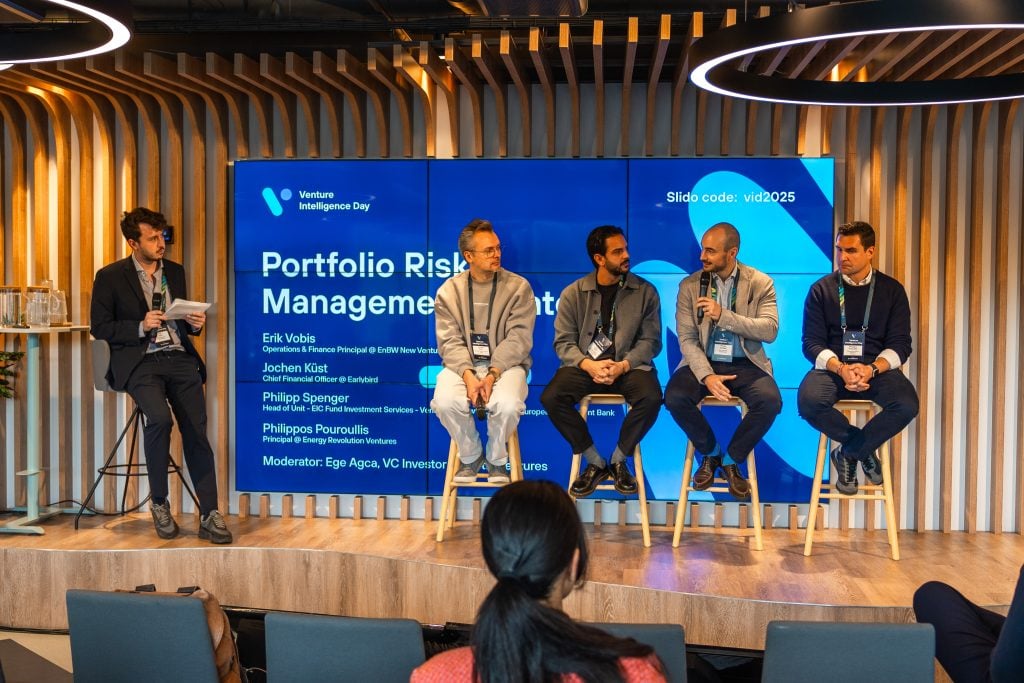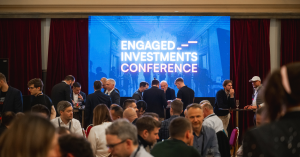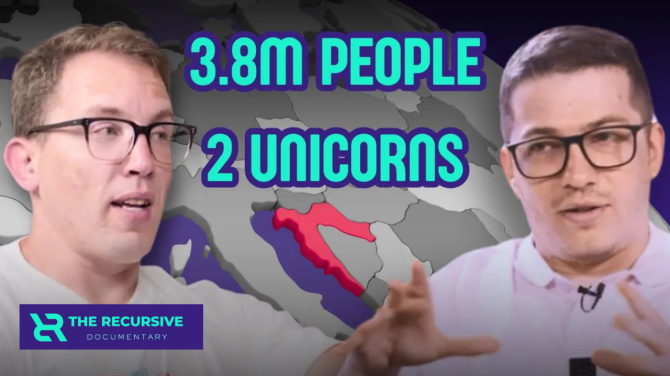Portfolio risk management strategies have evolved from a defensive discipline to a strategic capability, opened up Ege Agca, VC Investor at Metis Ventures and the moderator of “Portfolio Risk Management Strategies” panel at Venture Intelligence Day conference by Vestberry.
The panel quickly proved it wasn’t empty saying. Where risk used to be tucked away in back‑office spreadsheets, it now drives deal‑flow decisions, dictates co‑investment structures, and even shapes Europe’s strategic autonomy for critical technologies.
To discuss this point, Agca was joined by Erik Vobis, Operations & Finance Principal @ EnBW New Ventures,
Jochen Küst, Chief Financial Officer @ Earlybird, Philipp Spenger, Head of Unit – EIC Fund Investment Services – Venture & Growth Capital @ European Investment Bank, and Philippos Pouroullis, Principal @ Energy Revolution Ventures.
The panelists covering a wide spectrum of investing shared invaluable insights into how they approach risk in the ever-evolving landscape of venture capital.

The EIC Fund: Bridging public and private capital
Philip Spenger from the European Investment Bank (EIB) leads the Venture & Growth Capital operations of the EIC Fund – a 100% public fund and Europe’s largest and most active deep tech investor. With 312 investments totaling €1.4 billion to date, and plans for another 200-300 companies and €5 billion in the next three years, the EIC Fund leverages a data-driven VC approach.
By statute, it co-invests and won’t set terms. As Spenger put it: “We don’t want to make the market, we want to follow the market.” But “follow” comes with strings attached: keeping strategic assets in Europe. “We need to ensure that the companies that we are a shareholder in, that they remain with the headquarter and with the IP in Europe.”
Key takeaways from EIC’s risk management practices:
-
- Public co-investor model: The EIC Fund co-invests up to 50% of a round, requiring a qualified lead investor (VC, CVC, or corporate with a track record) to contribute at least 25%. This ensures market alignment and hands-on support for portfolio companies, something the EIC Fund isn’t built to provide.
- Geopolitical risk & strategic autonomy: While general geopolitical risks are less critical for early-stage startups, the EIC Fund’s mandate for European strategic autonomy means they actively monitor:
- Companies retaining HQ and IP within Europe.
- Shareholder composition, particularly the increase of non-EU investors.
- Data-Driven risk management: Utilizing tools like Vestberry, the EIC Fund: maintains updated cap tables to track shareholder composition and identify potential policy risks; monitors KPIs and milestones to assess company progress; leverages cross-portfolio intelligence through tools like “sector dashboard” to inform investment decisions, identify suitable co-investors, and gain insights into average valuations, dilution, and investor trends within specific deep tech sectors.
- Balancing policy goals and returns: The EIC Fund navigates the complexity of innovation in Europe, ensuring strategic independence, and generating returns. While they aim to keep strategic assets in Europe, they acknowledge the reality of global exit markets, where US acquirers are often the most likely for deep tech companies.
What risk looks like inside pure VC fund
Jochen Küst, CFO at Earlybird, one of Europe’s oldest German VCs, oversees a portfolio of roughly 60 active companies. Küst framed his job without romance: “The priority is that we identify the losers in the portfolio.” Not because founders don’t dream big, but because doubling down on the wrong names kills DPI and fund math.
In general, for Küst, risk management is multi-layered.
CFO’s top concerns:
-
- Fund level: DPI (Distributions to Paid-In Capital) and exits are paramount.
- Compliance & operational risk: Regulatory reporting, fulfilling deadlines, and managing “op risk” are constant challenges.
- Portfolio level: The highest priority is identifying “losers” early to avoid doubling down on underperforming investments. KPIs, management reports, and benchmarking tools are crucial here.
- Exit opportunities: Earlybird is acutely focused on exit plans and safeguarding DPI ambitions, especially as institutional and public investors increasingly prioritize IRR.
- Culture of support: Despite the critical role, Jochen emphasizes a culture where the finance team helps investment managers find solutions, rather than just spotlighting problems, ensuring internal alignment.
- Avoiding “falling in love”: A common pitfall for investment managers is becoming too attached to companies, potentially missing optimal exit slots. Earlybird’s “exit committee,” including the CFO and Chief Risk Officer, provides a neutral view to ensure timely and financially sound exit decisions.
Ensuring corporate VC’s priority
On the other hand, corporate venturing wrestles with two goals: hit returns, and help the mothership. Germany’s EnBW New Ventures walks that line with an evergreen fund and a autonomous team like a financial VC.
CVC brings in an additional layer of strategic risk compared to traditional VCs, though Erik Vobis views it more as an opportunity if managed well. “The number one priority should be having some financial return,” he concludes.
CVC risk management differentiators:
-
- Evergreen Structure: Offers flexibility in timing capital allocation for initial and follow-on investments.
- Leveraging corporate strengths: The large ENBW corporate (30,000 employees) provides vast expert knowledge to startups. Also, ENBW can act as a crucial first big client for startups, delivering significant contracts that directly impact valuation.
- Quantifying strategic alignment: They use a scoring system based on factors like product complementarity and expected contractual volume between ENBW and the startup.
- Investing flexibility: It’s crucial for a CVC not to constrain a startup’s growth purely on strategic alignment. If a startup thrives without integration with ENBW, the CVC is happy to support future rounds based on financial performance.
- Operational support: Rather than direct intervention, ENBW New Ventures facilitates exchanges and network connections. A successful example included connecting a startup with ENBW’s debt management team to improve receivables collection.
Deep tech’s overlooked risks
Energy Revolution Ventures sits at the spicy end of the spectrum. Philippos Pouroullis from ERV specializes in deep tech infrastructure, arguably one of the highest-risk and highest-impact segments. Electrochemistry, storage, renewable fuels, carbon capture, advanced materials, no wonder Seed and Series A relly heavy on technical diligence. As Pouroullis said out loud: “We don’t like to make things easy for ourselves.”
-
- Commodity Pricing: Often underestimated, fluctuations in prices like lithium, natural gas, or steel can massively impact business cases, either positively or negatively, and distort investment decisions.
- Geopolitical Risks: Changes in climate tech policy (e.g., US tariffs), trade wars, or restrictions on rare earth minerals can overnight alter the investment landscape.
- Diversification in Specialized Funds: While general wisdom is to spread bets, specialist funds diversify differently:
- Deep specialization allows for calculated bets alongside portfolio companies.
- Mixing heavy capital-expenditure solutions (e.g., hydrogen electrolyzers) with less capital-intensive “picks and shovels” plays (e.g., advanced battery diagnostics).
- The Follow-On Dilemma: For lead investors, deciding not to follow on can signal distress to the market. Energy Revolution Ventures mitigates this by:
- Being transparent about their specialization (Seed/Series A) and what they can offer. The market understands their focus may not extend to later-stage scaling.
- Leveraging their expert team and strategic LP base to open doors for companies, even if direct follow-on capital isn’t deployed.
The future of data in VC risk management
Looking ahead, the panelists agreed that data will become the nervous system of venture risk management.
Philipp Spenger stressed that “the data quality and the data consistency” are the foundation for any insight, insisting that future tools must automate cap‑table extraction while still “requiring a human brain” to validate the numbers. Jochen Kust added that “e‑invoices with attached datasets” will replace opaque PDFs. Vobis imagined a “strategic‑risk scorecard” powered by live market and operational metrics, while Pouroullis warned that without transparent, commodity‑linked data, “geopolitical shocks will stay blind spots.”
This Venture Intelligence Day panel covered spectrum of venture investing, but the panelists converged on a common truth: disciplined risk management that is data-driven is no longer a back‑office function. Together, they illustrated that effective risk stewardship, whether through granular data, early loss detection, strategic scoring or sector‑specific foresight, now defines the competitive edge of today’s venture capitalists.








